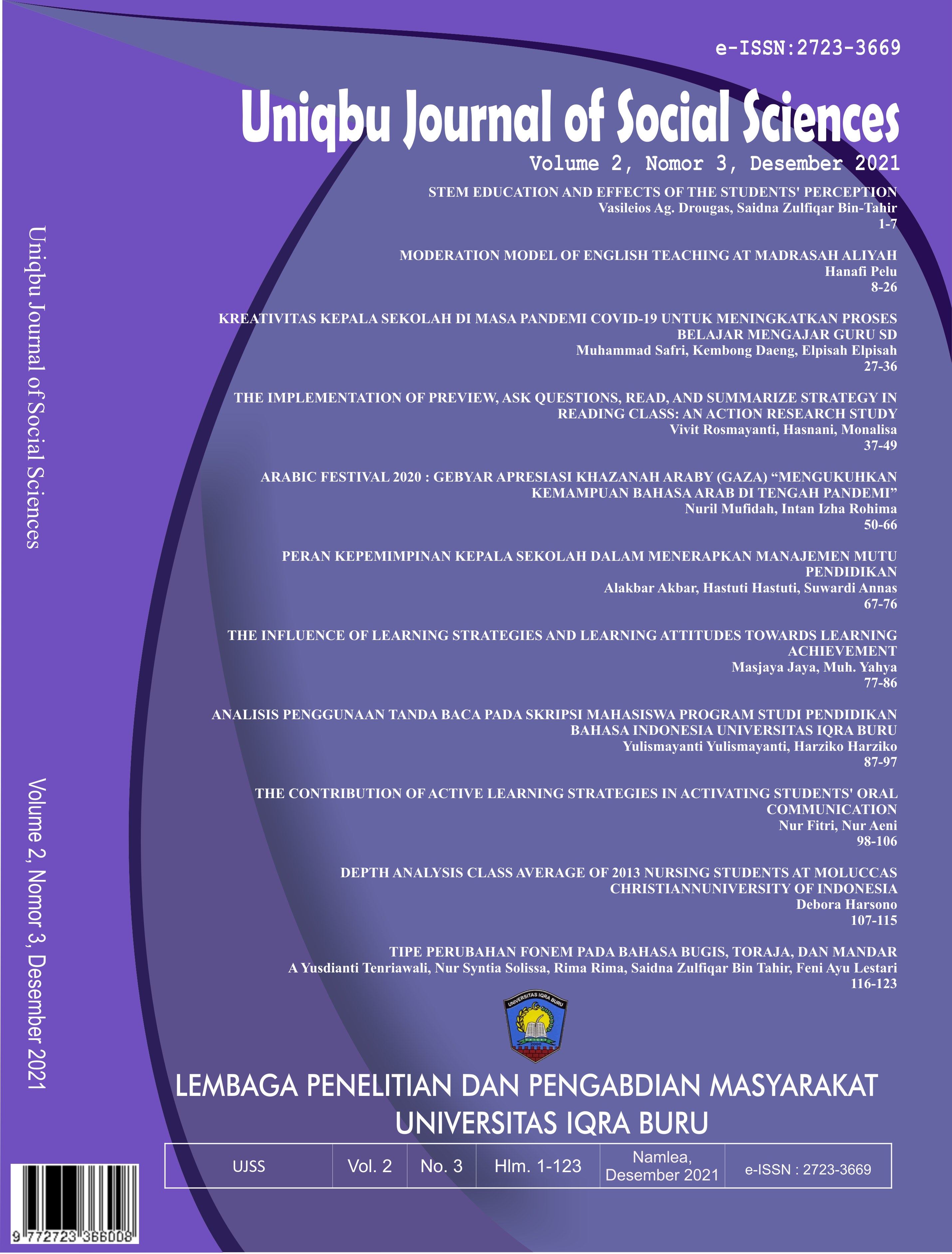TIPE PERUBAHAN FONEM PADA BAHASA BUGIS, TORAJA, DAN MANDAR
(Types of Phoneme Change in Bugis, Toraja, and Mandar)
DOI:
https://doi.org/10.47323/ujss.v2i3.168Keywords:
tipe, perubahan fonem, bahasa daerahAbstract
This study aims to analyze the types of phoneme sound changes in Bugis, Toraja and Mandarin languages. The research method used in this study is a qualitative descriptive method with data and data sources from 6 informants, each of whom masters Bugis, Toraja, and Mandar languages. Data collection techniques in this study used listening techniques, note-taking techniques, and documentation techniques. The data analysis techniques in this study include data display, data reduction, verification, and data inference. The results showed that the types of sound changes in Bugis, Toraja, and Mandarin include lenisi, sound addition, metathesis, and assimilation. Apocope lenisi type is more commonly found in Bugis, Toraja and Mandar languages than syncope. In sound addition, the most common data found were prosthesis data in Bugis and Mandarin. The metathesis type is only found in the comparison of Toraja and Mandarin, and only regressive assimilation types are found in Toraja and Mandarin. From the results of the analysis of the type of sound change, it shows that the Toraja and Mandar languages are closer, compared to the Toraja and Bugis languages.
References
Aminuddin. (2009). Pengantar Apresiasi Puisi Karya Sastra. Sinar Baru Algensindo.
Bal, M. (1985). Narratology: Introduction of the Theory of Narrative. University of Toronto Press.
Basuki, K. (2019). Jenis-Jenis Wacana. Jurnal Online Internasional & Nasional, 53(9), 1689–1699.
Bin Tahir, S. Z. (2015). Multilingual Behavior of Pesantren IMMIM Students in Indonesia. Asian EFL Journal, 86, 45–64. http://asian-efl-journal.com/9108/teaching-articles/2015/07/volume-86-august-2015-teaching-article/
Bin Tahir, S. Z. (2017). Multilingual Teaching and Learning At Pesantren School in Indonesia. Asian EFL Journal, 98, 74–94. http://hdl.handle.net/10535/10267
Danesi, M. (2012). Pesan, Tanda, dan Makna. Jalasutra.
Endaswara, S. (2011). Metode Penelitian Sastra. CAPS.
Giles, Judy & Middleton, T. (1999). Studying Culture: A Practical Introduction. Blackwell Publisher.
Luxemburg, Mieke Bal, dan W. G. W. (1991). Tentang Sastra. Intermasa.
Mahsun. (2017). Metode Penelitian Bahasa. PT Raja Grafindo Persada.
Nurgiantoro. Burhan. (2009). Penilaian dalam Pengajaran Bahasa dan Sastra. BPEE, 45–58.
Nurgiantoro, B. (2009). Penilaian dalam Pengajaran Bahasa dan Sastra. BPEE.
Soehartono, I. (2008). Metode Penelitian Sosial. PT Remaja Rosdakarya.
Taufik, dan Tenriawali, A. Y. (2019). “KAPATA PANAS PELA” NEGERI ARIATE DAN KATAPANG: TINJAUAN STRUKTUR DAN MAKNA KAPATA PANAS PELA VILLAGE OF ARIATE AND KATAPANG: STRUCTURE AND MEANING REVIEW. https://doi.org/https://doi.org/10.31813/gramatika/7.2.2019.217.155-164
Tenriawali, A. Y. (2019). BAHASA PRASANGKA SOSIAL DALAM CERPEN “CLARA” KARYA SENO GUMIRA AJIDARMA SOCIAL PREJUDICE LANGUAGE IN SHORT STORY “CLARA” BY SENO GUMIRA AJIDARMA: Vol. VII (Issue 1). Januari-Juni. https://doi.org/https://doi.org/10.31813/gramatika/7.1.2019.166.16--27
Waluyo., H. (2007). Teori dan Apresiasi Puisi. Erlangga.



